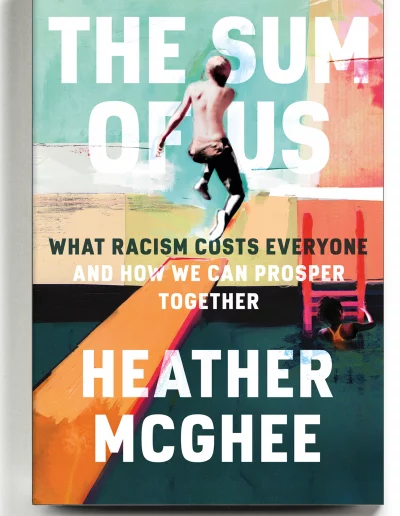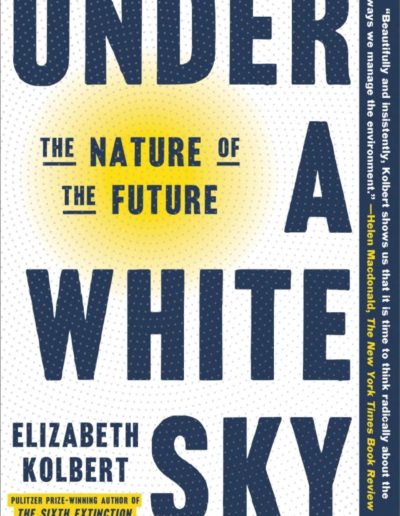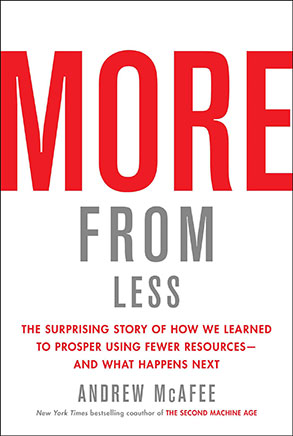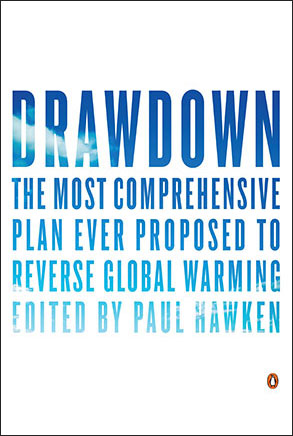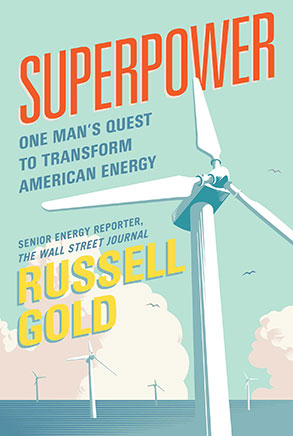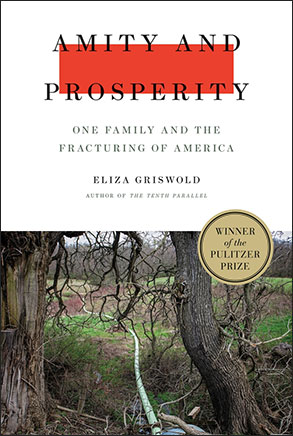What We're Reading
HASI Reading List Collection
The books lining our shelves help us to reflect on our core values and support ongoing engagement and connection with the world we all share. Every month, we gather to share insights on selected books that relate to our investment thesis and the economics, politics, physics, and the reality of climate change.
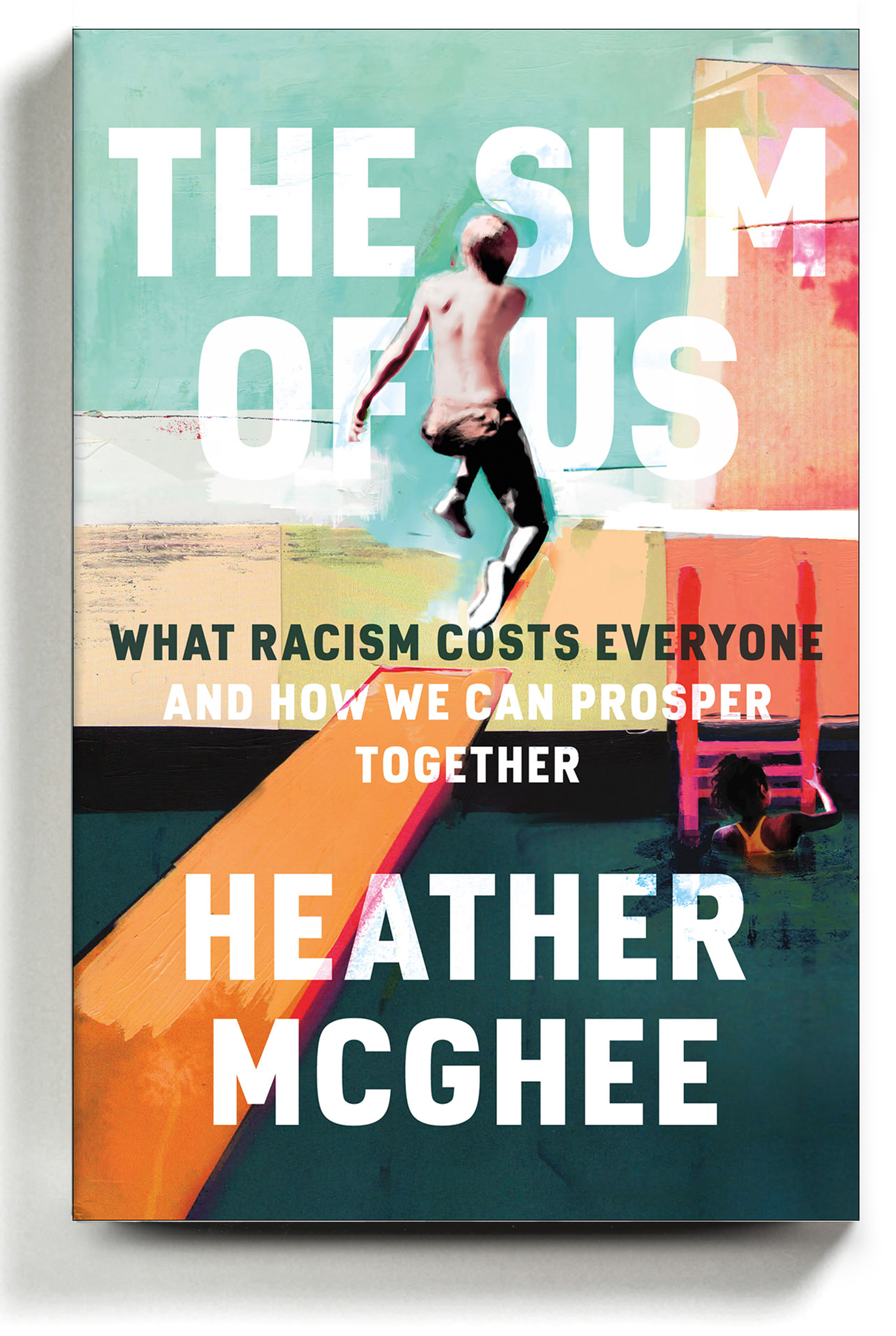
The Sum of Us: What Racism Costs Everyone and How We Can Prosper Together
By Heather McGhee
Reviewed by Michelle Guevara — IT Business Analyst
Why can’t we have nice things? In healthcare, education, and infrastructure–the U.S. continually ranks lower than comparable industrialized nations. Why? Why when faced with the choice to share public pools, communities choose to drain the pools and close them at a loss to everyone? Heather McGhee’s The Sum of US is a pointed and timely examination of the unequivocal reality that Americans have collectively accepted around the historical racial hierarchy conceived at the very founding of the nation, the continuation of which has led to innumerable and tangible losses for all of us, not just those immediately affected. That when we fall for the insidious belief that prosperity for some must come at the expense others, we all lose. Heather posits a parallel contrast to this zero-sum mentality, that when we embrace and seek to optimize for the collective wellbeing and equitable outcomes, we can all exponentially prosper.
read more...
In the case of climate change, this reality may be most prominently so. The illusion that some may be spared the consequences from decisions made in tolerance of sacrificing the wellbeing and safety of others is increasingly difficult to ignore. The rise in the prevalence of extremes in weather, droughts, wildfires, blackouts, and the poisoning of entire cities that result from neglected infrastructures, the injury and destruction is not as selective as those electing to disregard these realities may want to believe. The depth and breadth of the cost and impact to the health, safety, and security of all inhabitants on this planet is inextricably linked to our individual willingness to accept that we are not all in this together; that the cost born by “others” does not ultimately affect us too.
Through detailed stories and grounded research, the true cost of racism is laid bare, but examples and a clear framework are presented for an alternative path forward. Heather McGhee’s The Sum of Us: What Racism Costs Everyone and How We Can Prosper Together is a must-read for everyone, and hopefully will inspire more of us to have the courage to seek opportunities to work together to achieve the solidarity dividends yet to be realized.
Additional content from the author:
Heather McGhee, 2019 TED Talk – Racism destroys public goods and the public will to support them.
Video clip – How racism drives inequality for everyone. Discussion on the author’s experience through her work facing objections when making the economic case for caring for one another, the obstacle to our collective willingness to invest in our people and our future.
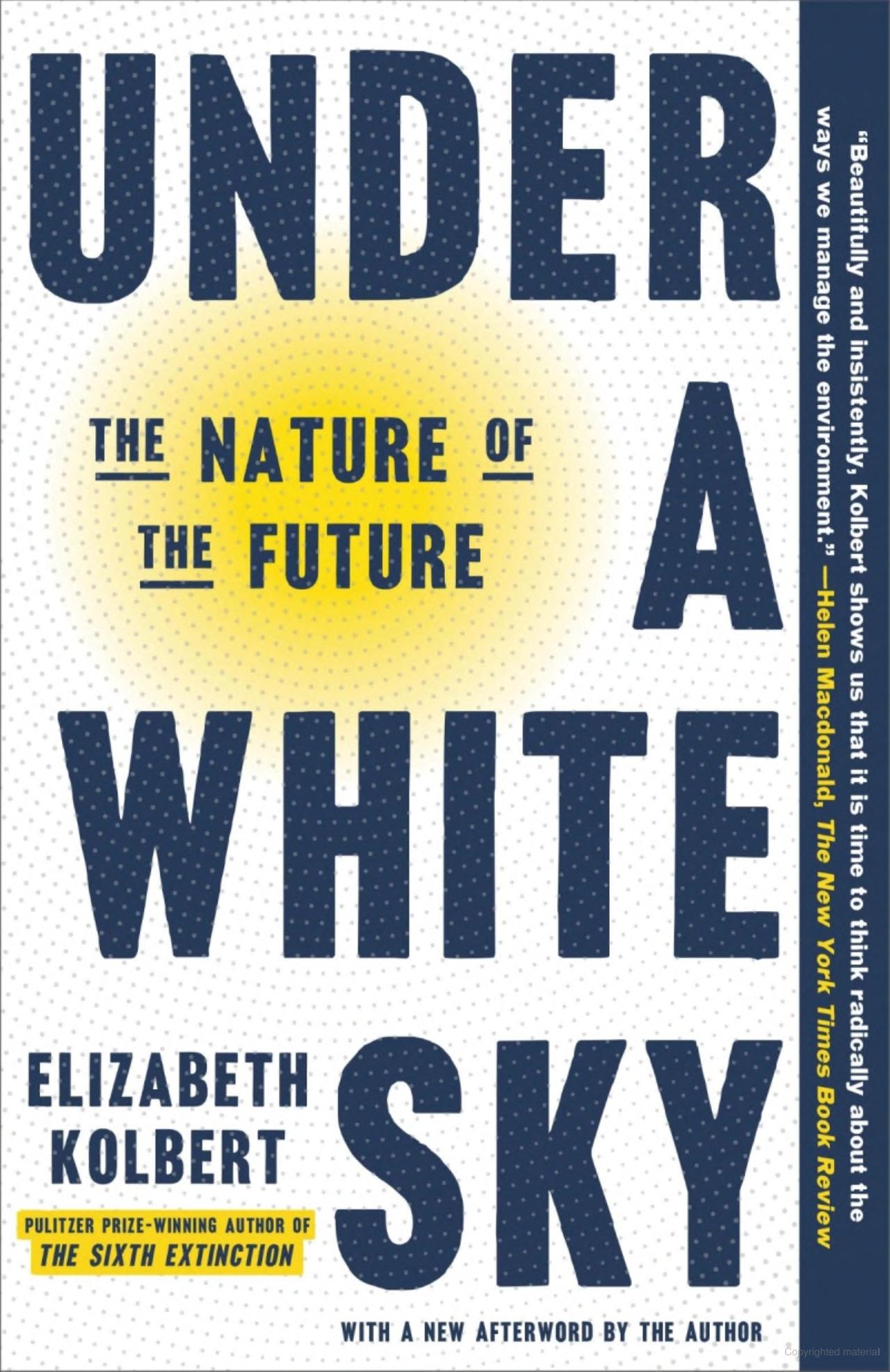
Under a White Sky: The Nature of the Future
By Elizabeth Kolbert
Reviewed by Manny Haile-Mariam, Managing Director – Structured Investments Team Lead
Elizabeth Kolbert’s Under a White Sky is a thought-provoking book that deftly explores humans’ impact on nature. The book’s central theme is grounded around people trying to solve problems created by people trying to control nature.
Humans have altered the planet extensively throughout time in our drive to control nature, leading to unintended consequences. The vast level of modifications we’ve made to the earth makes it so that even attempting to fix problems can ultimately pose other issues. A stunning fact shared to make a point of our impact on the earth was that “People have, by now, directly transformed more than half the ice-free land on earth — some twenty-seven million square miles — and indirectly half of what remains.”
read more...
Throughout the book, Kolbert goes into detail about this human impact on our only home. She documents meetings with biologists who are trying to preserve the world’s rarest fish, scientists editing the DNA of Cane toads in Australia to mitigate their impacts, Australian researchers who are trying to develop a “super coral” that can survive with increase in temperature, and many more cases. I found the colorful variety of examples Kolbert employed were very effective in communicating the gravity of the challenges created by humans trying to control nature.
Interestingly, Kolbert does not explore a solution or a path forward on what to do about the issues caused by humans documented so artfully in the book. Rather, she painted a picture of a future where humans are either unable to reverse the impacts of the past and need to manage its consequences or are left with a circular problem of continuing to control nature, and the subsequent additional issues that come with that. I found the book to be very stimulating in terms of the richness of its storytelling in describing human impacts on nature, but this certainly isn’t a very encouraging tale if you’re looking for a big dose of optimism.
As I reflect on the unanswered questions about what to do to solve some of environmental problems in this book, I could not help but think about the broader and heated climate solution debates in our country today. Anyone involved with making decisions about our climate should read this book. Our political environment has mistakenly simplified complicated problems to binary outcomes and along party lines.
Under a White Sky is a reminder that solving problems related to our planet is complicated and difficult! Failing to give these complicated challenges the respect they deserve will only lead to more negative consequences, whether intended or unintended, impacting future generations. The climate challenge should not intimidate us. It should inspire us to come together and solve it as best we can.
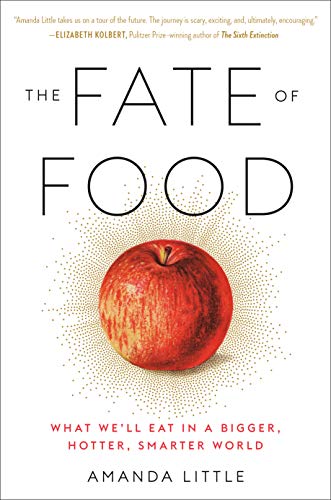
The Fate of Food: What We’ll Eat in a Bigger, Hotter, Smarter World
By Amanda Little
Reviewed by Jeb Bemiss, Senior Analyst – Structured Investments
In The Fate of Food, author Amanda Little explores the past and future of global food supply. She builds a convincing argument for the integration of technology into food systems to feed a growing population in the face of climate change.
Little skillfully weaves together personal anecdotes from her global travels with a technical discussion of developing agribusiness technologies throughout her book, addressing attitudes and misconceptions about controversial – yet necessary – solutions to food supply issues. Little touches on the costs and benefits of technologies like genetically modified crops, water desalinization, and vertical farming and details the value each will contribute to a more efficient and equitable future.
read more...
In this future envisioned in The Fate of Food, businesses, governments, and individuals will need to make substantial investments to improve resiliency and efficiency, eliminate waste, and distribute food and water to the most vulnerable populations impacted by climate change. The investments required will be significant, but the costs of inaction will be substantially worse.
The Fate of Food also thoughtfully discusses consumer attitudes and the psychology at the intersection of technology and food production. For example, genetically modified organisms (GMOs) have gained a reputation for being experimental and unsafe, despite consensus among scientists that they are not inherently riskier and do not cause disease. Little attributes discomfort with GMOs to a more pervasive distrust of corporate-industrial influence on the sacred food we eat. Likewise, the book addresses the “gross factor” of eating plant-based meats or lab-grown meat – foods that may seem unnatural and repel the average consumer. She deftly points out that in the face of constraints on arable land, resources, and harsher climates, communicating the safety and benefits of these ”unnatural” foods will be crucial to widespread acceptance and more reliable protein sources.
The Fate of Food provides an accessible introduction to the global food supply for readers of all backgrounds and levels of expertise. I found the discussion in her book fresh and incredibly relevant in a rapidly changing global economy. As climate change accelerates the challenges to our food supply, The Fate of Food will become increasingly crucial for decision-makers on where to invest our limited resources to secure a better future for our food and ourselves.
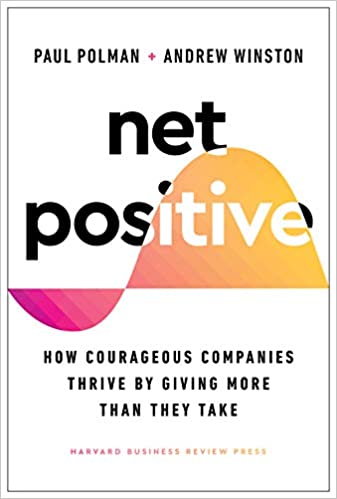
Net Positive: How Courageous Companies Thrive by Giving More Than They Take
By Paul Polman and Andrew Winston
Reviewed by Gil Jenkins, Vice President – Corporate Communications & Public Affairs
Profits should come not from creating the world’s problems but from solving them. Companies must ask themselves: Is the world better off because your business is in it? These are just a few of the urgent and inspiring lessons offered in “Net Positive: Courageous Companies Thrive by Giving More Than They Take,” co-authored by Andrew Winston, a globally renowned sustainable business author and advisor, and Paul Polman, the visionary former CEO of Unilever.
The last several years have laid bare the challenges facing our country and our world: widening economic inequality, glaring forms of racial injustice, and more severe natural disasters caused by a changing climate. In an era when more people place their trust in businesses than government, the authors astutely and convincingly detail why companies have a moral obligation to help solve some of the great challenges of our time. Drawing from the practices and principles of businesses large and small, Net Positive builds a roadmap for how companies can not only find purpose by putting people and the planet first, but also prosper in the process.
read more...
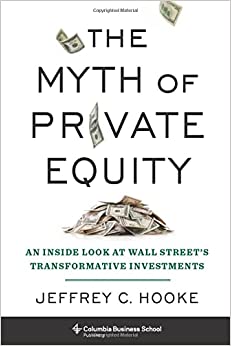
The Myth of Private Equity: An Inside Look at Wall Street’s Transformative Investments
By Jeffrey C. Hooke
Reviewed by Josh Garrett, Senior Director – Structured Investment Team
Jeffrey Hooke’s The Myth of Private Equity is an eye-opening expose of the industry and the complex web it weaves. Interwoven incentives and disincentives are brought to life through real-world examples illustrating the personal and professional demands on those connected to the private equity (PE) industry. The author’s perspective comes from decades in and around the industry as both an academic researcher and former private investment executive, which textures the analysis with compelling insights into the game of maximizing fees on both real and, perhaps, imagined investment performance. He offers empirical evidence for flaws in the fundamental strategies of the leveraged buyout industry, the saturation of firms chasing private companies, and the resulting decline of PE returns vs. a simple 60/40 portfolio of public stocks and bonds in recent decades.
read more...
Hooke provides terrific over-the-shoulder views of the principal-agent conflicts that pension managers face with PE. He argues that the basis for PE success lies not within market-beating returns, but in coopting the personal incentives of limited partners: by investing in PE with estimated and smoothed returns, they can delay cash funding requirements from taxpayers (which eventually become due at a multiple). Additionally, the complexity of selecting PE funds and other alternative investments provides job security to managers and consultants. What about asset class diversification? Hooke covers that as well—and the data for most alternative investments do not impress.
Hooke makes the case against smoothing returns, for example, by arguing that PE returns should align with the S&P 500 as adjusted for leverage, and a behavioral economist’s perspective on the sometimes-irrational behavior of public markets would be interesting to consider. Second, the practical benefit of PE lock-up periods is worth considering further, as not allowing LPs to sell at a bottom may be a competitive advantage relative to public equity funds. Finally, where the book touches on alternative investments broadly, it would have been interesting to delve into which asset classes do empirically provide diversification and/or return benefits.
If this book became required reading for all pension managers and their consultants, it is not hyperbole to say that the world might be a better place. The book is well argued, backed by research, and ultimately worth reading for anyone concerned with rising income inequality and the use of taxpayer funds. This book should also be read by anyone considering entering the PE industry or its broader ecosystem.
In recent months, the SEC has begun to focus on the fees paid to private equity funds, proposing they should be subject to closer scrutiny as part of a broader effort to boost efficiency, competition, and transparency in the markets. As a company, we are focused only on investments that improve our climate future, and to this end, we track the carbon reduction impact of each and every one of our investments. Recently, we have engaged with the SEC on the related issue of mandatory, accurate, and carbon-focused ESG reporting. We see the emergence of many dubious ESG certifications as another path for undue enrichment. The issues at hand in The Myth of Private Equity are more impactful to everyday lives than one might suspect and are actively being considered by policy makers; Hooke’s The Myth of Private Equity is an important voice to consider in this discourse.
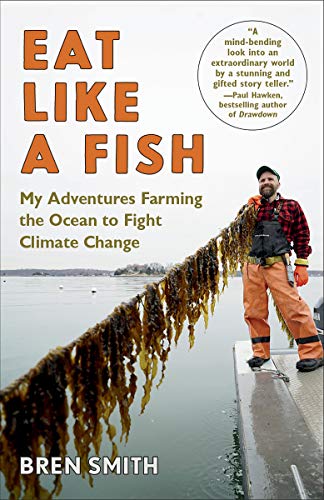
Eat Like a Fish: My Adventures Farming the Ocean to Fight Climate Change
By Bren Smith
Review by Hilary Langer, Director – Middle Office, Portfolio Management
A book about climate change that I can read before bed without spiraling into existential dread? Bren Smith’s memoir, Eat Like a Fish, is that rarest of books that left me more optimistic about the future of our planet. At turns hilarious, hopeful, and pragmatic, Smith narrates his journey from fisherman to restorative ocean farmer.
Since his childhood days selling cod tongues door-to-door in Newfoundland, Smith has relied on the ocean for inspiration and income. His love for working on the water draws him to lobstering and fishing, but his prospects are challenged by ecological breakdowns. In 1992, the Canadian government issued a moratorium on cod fishing due to the massive stock depletion from overfishing. It was “the biggest layoff in Canadian history,” directly impacting the livelihoods of 30,000 people. Troubled by threats to both the culture and the economy that define his world, Smith describes his search for a way to make a living on the ocean without depleting it. A stint working in aquaculture leaves him disheartened by inefficiency and pollution. An investment in an oyster farm seems promising until it is wiped out—twice—by historic back-to-back storms: Hurricane Irene and Hurricane Sandy.
read more...
Smith’s relentless curiosity, research, and tinkering finally converge on a solution: restorative ocean farming. By deploying an inexpensive system of vertical underwater structures that can be raised and lowered to evade storms, Smith is able to grow oysters, mussels, clams, scallops, and kelp. Smith’s regenerative ocean farming avoids the vices of land-based agriculture: it requires no inputs of pesticides, fresh water, or even land. Yet it produces protein and nutrient dense foods while absorbing significant carbon and nitrogen, providing habitat for fish, and reducing local ocean acidification. Most importantly, it allows Smith to make a satisfying living on the water.
Smith presents a crucial voice in the climate change conversation: that of someone whose livelihood depends on a healthy planet. Eat Like a Fish is a love letter to the ocean that doesn’t get lost in sentimentality or academic jargon. With humility and humor, Smith offers a glimpse into one industry’s turmoil and a path for redefining our relationship with the ocean.
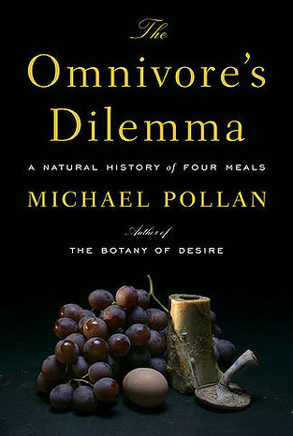
The Omnivore’s Dilemma : A Natural History of Four Meals
By Michael Pollan
Review by Nate Rose, Co-Chief Investment Officer
In what has become for many the seminal book about food and agriculture, Michael Pollan explores the American food system through the lens of four distinct food chains, each culminating in a meal. Pollan describes in eye-opening detail the origins of the industrial, organic (industrial and pastoral), and hunter-gatherer systems and where they fit into the American diet today. From government policy to the economic decisions that have influenced food markets, Pollan describes how food in America has evolved to a largely uncomfortable and unnatural place where food is cheap, plentiful, and made of substances that are hard to pronounce and identify. Pollan gives the reader a rich analysis of the four food chains, which is important for understanding how far we have come from our earliest ancestral approach to eating.
In reading this book for the fourth or fifth time for this review, I was struck by how current and relevant this book from 2007 still feels today. Pollan has created what is truly a timeless critique of the American food system and where we have gone wrong over the years. As an American eater, reading The Omnivore’s Dilemma is not only an entertaining and educational process – it is also a staggering reminder of how eating in America is more than meets the eye. As an omnivore, humans have endless choices for how to consume the food that sustains our lives, and Pollan reminds us just how complicated, challenging, and evolving that decision process is.
read more...
The Omnivore’s Dilemma will challenge the reader to think more critically about what and how they choose to eat, and for those with a focus on climate change, it will also cause them to think about how those choices impact the environment. My own journey with food choices began by reading Pollan’s powerful account in this book, and that has forever changed me. I hope more colleagues and anyone reading this review gets the same spark from these pages – opening a profound shift in their dietary lifestyle as a result.
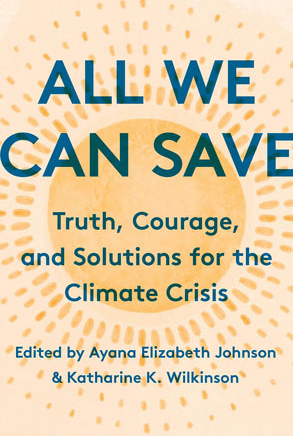
All We Can Save: Truth, Courage and Solutions for the Climate Crisis
By Ayana Elizabeth Johnson, Katharine K. Wilkinson (Editor)
Review by Lareina Wang, Associate – Private Investment Team
Curated by two climate leaders, Ayana Elizabeth Johnson, a marine biologist, policy expert, and conservation strategist, and Katharine Keeble Wilkinson, author, strategist, and editor-in-chief at Project Drawdown, All We Can Save is an insightful anthology of writings from an assortment of dedicated, down-to-earth female leaders at the frontline of climate action.
Throughout this book, the messages delivered are clear: climate issue impacts everyone, and we will need grand and systematic changes to tackle the crisis. What this book point is unique to point out, however, is that we too often underestimate the influence of acting within our individual expertise. And these leaders are here to remind us that we can all be part of the solution by starting small.
In bringing together voices of essayists from varied backgrounds, including scientists, journalists, farmers, lawyers, teachers, designers, investors, indigenous activists, and policymakers, All We Can Save elevates forward-looking and solution-orientated conversations from a range of women with unique experiences and perspectives.
read more...
To organize the vast spectrum of coverage, the book unfolds in eight distinctly themed chapters (Root, Advocate, Reframe, Reshape, Persist, Feel, Nourish, and Rise). For example, the “Advocate” chapter highlights the critical policy-making perspective in showing the kinds of legislative efforts needed to hold the powerful accountable and push for climate policies that benefit all people. “Nourish” focuses on nature and demonstrates that every part of our ecosystem is inseparable and intertwined. In “Rise,” the essayists highlight proactive collaboration stories across generations, industry sectors, and communities. It is also noteworthy that each chapter includes beautiful artwork and poems that perfectly fit the theme.
In sum, all forty essays are well-written and informative. I found the following contributions particularly intriguing, as they provide a closer look at specific climate solutions and environmental subjects that I hadn’t paid much attention to before:
• “Indigenous Prophecy and Mother Earth,” where Sherri Mitchell Weh’na Ha’mu Kwasset reminds us that indigenous knowledge exists as a millennia-long study carrying thousands of years of history on coping with environmental variability and finding harmony with the world around us, yet for so long, it has been underappreciated and misrepresented in mainstream narratives;
• Jane Zelikova’s “Solutions Underfoot,” which zooms the lens on soil, a regularly overlooked resource that contains enormous carbon-banking potential. Decades of ecologist research makes Zelikova realize how climate change disrupts ecological relationship and lowers soil fertility, but it is also her research that suggests simply by feeding microbes we can bring back healthy soil;
• “Like the Monarch,” where Sarah Stillman warns that natural disasters do not only induce climate refugees but put pre-existing migrant communities more vulnerable to extreme weather, and underscores the urgency for our system to get prepared for the scale of climate displacement from both domestic and across the border;
• Jainey K. Bavish’s “A Tale of Three Cities” compares and contrasts practices coastal cities like New Orleans, Honolulu, or New York City have been taking to build city infrastructure’s resiliency against climate change impacts. From adaption to transformation, Bavish acknowledges the possibility of community-driven projects and urges cities to factor climate risks into every public investment in the future.
Despite some overlap in ideas and messages being addressed by different essayists, All We Can Save is generally a satisfying read. The refreshing outlook this book offers has inspired me to explore future writings and project updates from several of the contributors to this anthology.
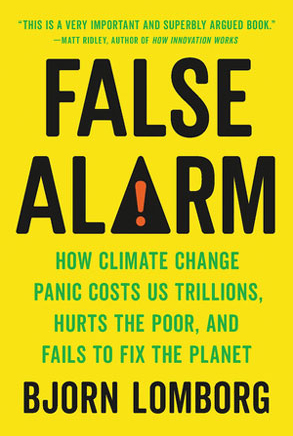
False Alarm: How Climate Change Panic Costs Us Trillions, Hurts the Poor, and Fails to Fix the Planet
By Bjørn Lomborg
Review by Tyler Broyles, Manager – Accounting
In False Alarm: How Climate Change Panic Costs Us Trillions, Hurts the Poor, and Fails to Fix the Planet, Bjorn Lomborg argues that our current attitudes around climate change, including how we discuss it in the media and our plans to combat it, are counterproductive and do more harm than good, particularly to those in developing nations. Lomborg’s primary thesis is that a combination of adaption and innovation, combined with a carbon tax, represents the best way to maximize the welfare of the planet’s citizens versus rigorously pursuing the Paris Climate Accords’ goals.
Much of Lomborg’s analysis depends on the assertion that renewables such as wind and solar are too expensive when compared to traditional fossil fuel sources. He primarily cites lower market share as evidence for this rather than current cost studies, which show that wind and solar are often cheaper than coal and that in certain circumstances, it’s cheaper to build, a new wind plant that to continue to operate an existing coal plant. He makes no mention that renewables such as rooftop solar would help contribute to the adaptive response he correctly highlights will be needed in the coming decades.
read more...
Lomborg uses GDP as a barometer of human welfare, stating early in the book that historically, it has been a good yardstick for happiness and life satisfaction and more traditional living standards. This is all well and good, but when Lomborg discusses GDP projections under various climate change response scenarios later in the book, one has to wonder if the results wouldn’t be different if we placed different monetary values on things like biodiversity, as compared to the various studies Lomborg cites.
False Alarm’s best contributions to the current dialogue around climate change are the discussions around adaptation. Lomborg writes that infrastructure is already being built to mitigate the impact of flooding in low-lying areas, and behavior can be altered, so we no longer build expensive structures where floods and wildfires are anticipated. He keenly observes we are not often willing to discuss these as options, as it can feel defeatist. Still, they should be on the table as even keeping temperature increases to moderate levels will result in increased weather events. Lomborg’s call for a carbon tax is supported by economists of all political leanings and would be a welcome addition to the climate fight. The arguments in False Alarm differ from other arguments against the prevalent approaches to climate change in that it is science-based and focuses on maximizing human welfare rather than particular special interests, which is commendable.
Informed readers who are interested in differing perspectives on climate change will find much to digest in False Alarm. However, they will undoubtedly disagree on specific points and may take issue with Lomborg’s tone in certain places. Unfortunately, it is easy to see Lomborg’s argument being hijacked by those whose vested interests are not with humanity but rather preserving their entrenched interest in a dirty energy economy, so False Alarm should be read in concert with other legitimate climate perspectives.
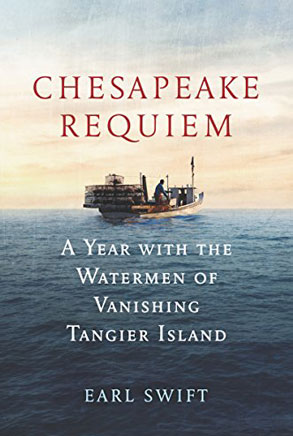
Chesapeake Requiem: A Year With the Watermen of Vanishing Tangier Islands
By Earl Swift
Review by Sean Keller, Associate – Portfolio Management
Life in the town of Tangier, Virginia, has never been easy. Early 1800s Methodist inhabitants prayed for an afterlife free of island hardships. Today, the roughly 450 residents of Tangier are praying to be able to continue to withstand these hardships in their homeland. In the last ~160 years, Tangier has lost two-thirds of its landmass, with experts predicting Tangier can be uninhabitable in as few as 20 years. They are desperately trying to avoid becoming the United States’ first climate refugees, as their island shrinks due to sea-level rise, erosion, and post-glacial rebound (a.k.a. sinking). The residents of Tangier are primarily commercial watermen. Their livelihood depends on the water, and now water is what is threatening their everyday lives.
read more...
In Earl Swift’s New York Times best-selling book, Chesapeake Requiem: A Year with the Watermen of Vanishing Tangier Islands, Swift reports on his roughly two years of life on Tangier, on and off from late 2015 through 2017. He tells the story of Tangier’s townfolk on a person to person basis, using one-on-one interactions to provide a unique look into both the history of the island and the daily life of its people. Swift goes into tremendous detail in relaying both his own experiences on Tangier, and the rich stories the Tangier Island residents reveal. This apt usage of colorful dialogue and vivid storytelling makes for an enjoyable and page-turning read.
One of the more powerful notions portrayed in the book is the notion that with formerly inhabited areas now covered by the sea, Tangier residents are literally and metaphorically stepping into the past, while also seeing into their future. You do not have to look very hard to quickly learn that Tangier has a very religious and conservative population, with roughly 87% of the population voting for Donald Trump. Many residents do not believe in climate change, and while Swift does, he presents his opinions about Tangier in a far more unbiased way than others who have chronicled the plight of the Island and its people.
I split my consumption of the book between the print copy and audiobook, which is narrated beautifully and is equally enjoyable as the written version. In sum, Chesapeake Requiem offers a poignant and deeply personal glimpse into a community on the front lines of a climate breakdown that will eventually reach everyone, indifferent to whether they believe in the science and urgency of the climate crisis.
More From Less
By Andrew McAfee
Review by Chaz Gladden, Analyst – Portfolio Management
In an age where environmental “doomsday” scenarios have become increasingly common, it was refreshing to read McAfee’s optimistic perspective on the future of humankind.
The book takes the reader through various catastrophic views in our history, including the theories of Robert Malthus on population fluctuations, William Jevon’s fear of resource depletion (a.k.a. Jevon’s Paradox), and Paul Ehrlich’s belief that global famine was an inevitability.
In McAfee’s view, the common denominator in the fallacy put forth by these peddlers of catastrophism is that they grossly underestimate the power of human ingenuity. It is this ingenuity that has led to technological innovations such as the steam engine, vaccines, computers, and more. McAfee argues that capitalism is the main driver behind these innovative technologies which have significantly improved the human condition.
read more...
Today, capitalism has become a polarizing topic, in part because many pundits attribute climate change to the greed of big business. While McAfee concedes that capitalism has contributed to a fair share of environmental issues, he asserts that capitalistic principals are essential to dematerialization needed to mitigate climate change. McAfee explains that a competitive system which allows people to reap the rewards of their efforts will create a continuous effort to innovate, and thus limit the materials that are being used. Very simply, it’s the idea that with a competitive market, people have an inherent incentive to drive down costs. A very tangible example of this principle in play is the evolution of the cell phone. McAfee astutely points out that the modern cell phone has replaced over a dozen devices one would have typically purchased from a Radio Shack 15+ years ago.
Another great example McAfee provides is the aluminum can. Amazingly, when the aluminum cans were first introduced to the market in 1959, they weighed 85 grams. In 2011, aluminum cans only weighted 13 grams. This continued effort to drive down costs in the United States is a big reason why the nation is past its peak resource consumption but producing more than ever before.
Later in More from Less, McAfee goes on to contrast the relative efficiency of capitalism with the inefficacious economic philosophies of socialism and communism. The most startling example of this is highlighted by the ghastly overhunting of whales done by the USSR, which helped drive the humpback whale to near extinction. The Soviet Union had little economic use for the whale, as often the dead whales were simply thrown back into the water. This overhunting of the whale was simply an unscrupulous way of meeting the fishing quotas set by central planners.
While McAfee does an excellent job guiding the reader through the history of dematerialization, the book left me wanting more from the “What Happens Next” notion expressed in the subtitle. For example, McAfee proposes nuclear as a potential long-term energy solution but does little to detail how nuclear will be able to overcome the safety and waste management concerns. Instead, he writes off nuclear’s lack of widespread implementation as something primarily due to the irrational fears of the public. In general, McAfee’s view on the future could be summarized as: smart people have figured out solutions in the past, and if adequately incentivized, the intelligent people of the future are bound to find solutions in the future. Personally, I think that this mindset can be dangerous in that it often leads to apathy and inaction.
While the analysis of the future is a bit limited, More from Less is a well-written and thought-provoking book that I would recommend to anyone who would like solace in these uncertain times.
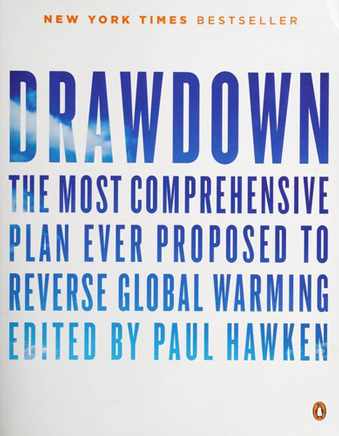
Drawdown: The Most Comprehensive Plan Ever Proposed to Reverse Global Warming
By Paul Hawken
Review by Gil Jenkins, Director of Corporate Communications
Edited by the longtime environmental advocate, entrepreneur, and author, Paul Hawken, Project Drawdown: The Most Comprehensive Plan Ever Proposed to Reverse Global Warming, is a wide-ranging and mostly approachable collection of short essays from leading scientists, researchers, and policymakers.
The title of the book refers to the atmospheric point where greenhouse gas emissions peak and begin to decline year to year. Using this notion, Hawken’s Project Drawdown team of 70+ research fellows and a related coalition of scientists, policymakers, students, activists, philanthropists, and investors have aimed to identify, measure, and model the 100 most substantive climate solutions that our society could accomplish by 2050.
80 of the 100 total solutions in the book, (which was first published in 2016, and updated online at drawdown.org are organized into chapters covering energy, food & women, buildings & cities, land use, transport, and materials.
Importantly, the actions listed among that 80 are concrete approaches that are already taking place across the globe today – many of which will surprise the reader both in terms of ingenuity and practicality. There’s also a bookend chapter of “coming attractions” that highlights 20 more climate solutions that could be game-changers in decades ahead but aren’t quite ready for prime time today.
read more...
In interviews, Hawken has talked about a sequel that would offer 60 more coming attractions. That sounds great, but I wonder if that’s necessary, given the diversity of the 100 solutions already laid out here, which deserve further analysis and modeling.
While I wish this book was published 30 years ago, it’s still an incredibly valuable resource for the times we live in. It’s very easy to go to that dark place if you’re a regular climate news consumer. And if you find yourself that camp occasionally, as I do, Hawken’s book does deliver a steady dose of optimism. You get the sense that “humanity is on the case and humanity is brilliant,” as Hawken remarked on an episode of Real Time with Bill Maher while promoting the book.
As I read Drawdown and reflected on my own time working on clean energy, climate policy, and corporate sustainability issues, it was valuable to garner digestible new insight on both the prominent and relatively unknown clean energy technologies that I’ve endeavored to promote at various points in my communications career. It was pleasing to see chapters devoted to unheralded but novel solutions – such as the section on smart glass, or “transition lens, except for buildings” as I use to tell folks.
Given what we do at Hannon Armstrong – climate solutions investing – it was encouraging but not surprising to see many top-ranked solutions where we currently have a financial stake. In the energy chapter, these investment interests include onshore wind (#2), energy microgrids (#78), rooftop solar (#10), solar farms (#8), energy cogeneration (#50), grid flexibility and energy storage (tied for #77). Under land use / And in building & cities, we’ve got a stake in net-zero buildings (#79), retrofitting (#80), green roofs (#73), LED lighting (#44), heat pumps (#42), and building automation (#45).
In chapters where our firm isn’t currently invested, such as food & agriculture, it is surprising to learn that food waste is the number three solution overall. In this chapter, I was also pleased to see the inclusion of what is probably the best available primer on regenerative agriculture as a practice (#11) – a solution that is getting a bit more visibility now having popped up during a recent Democratic Party presidential primary debate.
The chapter on transport offers the least amount of surprises for me personally, although I was surprised that electric vehicles weren’t ranked higher than the number 26 given their dominance in the conversation around low-carbon solutions.
Drawdown isn’t without flaws. Critics have rightly pointed out the gaps in the measurement approach – namely that it does not consider the physical and economic interdependence among the top 80 solutions, such as access to capital and resource scarcity from growing demand.
However, Hawken and the Project Drawdown team that put this together have readily acknowledged that their work will continue to evolve and adapt to any perceived inconsistencies. They see this entry as just the “tip of the iceberg”. And I find that kind of ambition in service of educating the world about carbon reduction pathways laudable.
Despite a few limitations, Drawdown remains one of the few books out there which focuses more on solutions than the doom and gloom apocalyptic narrative of climate change.Drawdown offers a necessary injection of hope for avoiding the worst impacts of climate change. And if you are a curious soul seeking a reference guide on how to solve global warming, this book is for you.
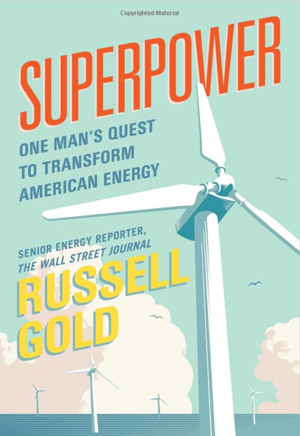
Superpower: One Man’s Quest to Transform American Energy
By Russell Gold
Review by Susan Nickey, Managing Director
So close, but yet so far is the sentiment that kept popping into my mind as I pored over this heart-wrenching documentary of an ambitious quest by a renewable energy pioneer and visionary to transform the energy landscape in the U.S. Superpower deftly chronicles the history of the utility-scale wind industry in the U.S. from an alternative small “green weenies” group (1-2% of the energy mix) to becoming a mainstream, competitive energy source with fossil fuels and a solution to meaningfully address climate change.
The author, longtime Wall Street Journal energy reporter Russell Gold, offers a historical framework of regulatory policies that have both promoted renewable development and thwarted the transformation of our grid powered predominately by renewables. In doing so, readers are left with a deep appreciation for the role policy leadership plays in the eventual outcome.
read more...
Gold’s background sets the stage to introduce the grand vision of Michael Skelly and his quest to build a new transmission superhighway system to connect the country’s best renewable energy resources to areas that demand a lot of power — in the most cost-effective way possible. The story of Skelly’s company, Clean Line Energy, highlights what is now technologically and economically possible for private sector investment in a modern grid infrastructure desperately needed in America. While time ran out for Clean Line, the groundwork laid provided a critical path forward that others will undoubtably follow. Moreover, the lessons we learned from this episode will be essential to overcome the remaining roadblocks thwarting our clean energy future.
I was moved by the very first introduction of Michael Skelly, the protagonist of the story, and his inspiration to do something about climate change with an ambitious plan to change the U.S. transmission system. Gold writes entertainingly about Michael’s background as he entered the U.S. wind industry in 2000, learning what it takes to be a successful developer, and to be profitable at it! Michael led Horizon Wind (and its predecessors) as the Chief Development Officer at the beginning of the U.S. wind industry business until it was sold to EDPR Renewables for over $2 billion in 2008, then the second-largest wind power company in the U.S.
Reading these passages took me back to the time when I was working in the U.S. wind industry as an investment banker in the late 90s. I still remember when Michael first called me looking for tax equity solutions – a desert at the time before JPMorgan entered the market.
As the book unfolds, we learn more about the incredible tale of Clean Line Energy Partners. Wind power was now becoming mainstream, reliable, and economical, but the transition to a meaningful renewable energy supply requires a new transmission system – billions of dollars of infrastructure investment. Knowing the best wind resources in the U.S. blow in sparsely populated places like the Oklahoma Panhandle while the large demand centers are far away, Michael saw the novel solution of an interstate transmission system. The analogy is drawn between the interstate highway system built with vision and federal eminent domain powers and its transformation from the intrastate, local highway system for road travel. Gold’s approach helps the reader visualize the problem and opportunity with our current outdated transmission system. A key difference, which would seem to be positive, was Michael’s vision to build this infrastructure privately and profitably. I can personally attest that when Michael surveyed the wind industry and financial leaders – “is this crazy?” – there was an acknowledgment of the huge challenge, and at the same time, it spurred new thinking about how to participate in a strategy to overcome the problems that would come up. It’s a strategy that if successful, would brilliantly address the opportunity to capture the abundant wind resources in the middle in the country.
The human, political, and economic capital invested in Clean Line’s strategy is a testimony to the viability of the grid transformation strategy we need in this country. And the heart of the issue lies with the Founding Fathers’ compromise to form our government – and the classic tension between federal vs. state powers. Given that climate change issues cut across all state lines let us hope this book is a wakeup call to rally for a greener future which is technically feasible, and economically profitable.
I loved how the book’s title was chosen to refer to people like Michael Skelly who think big and have the inspiration and drive to tackle the biggest challenges of our time, while persistently overcoming obstacles.
Michael, like the people in our company, share a commitment to showcasing how business can tackle climate change while generating a positive capital return. Many of us have devoted our careers (long or short) to create a virtuous cycle between capital and climate action. And despite these setbacks, the promise of clean energy chronicled in Superpower illustrates the vital payoff.
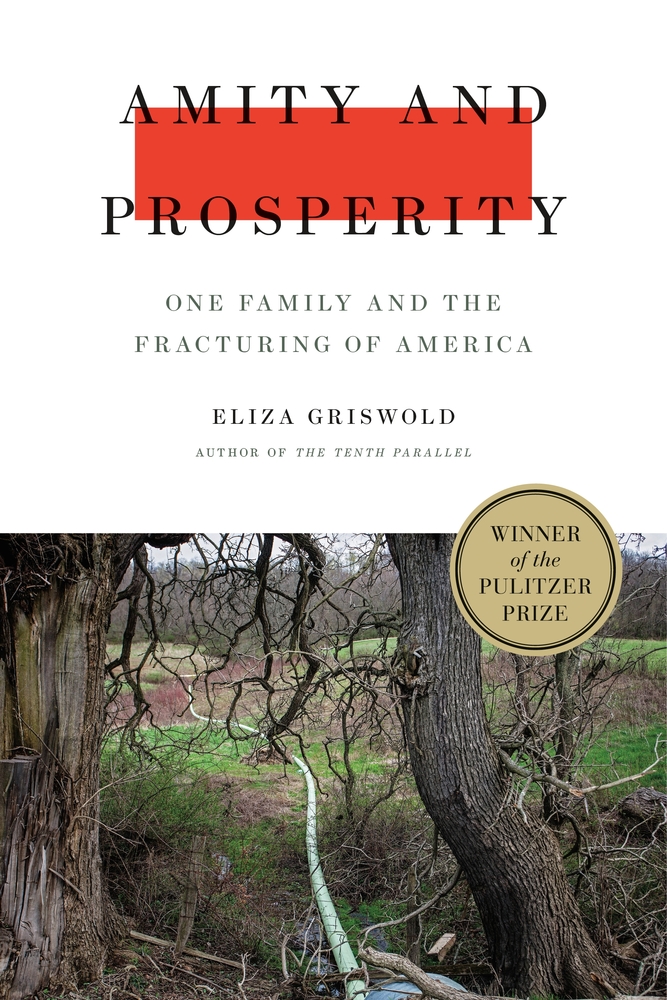
Amity and Prosperity: One Family and the Fracturing of America
By Eliza Griswold
Review by Jeff Lipson, Chief Financial Officer
At the core of this well-written, non-fiction story is several themes. As with the 2016 best-seller Hillbilly Elegy, Amity and Prosperity provide a thoughtful glimpse into life in Appalachia (Amity and Prosperity are two towns in rural Washington County, Pennsylvania). Another theme is of an overwhelmed single mother relentlessly attempting to determine the cause of her son’s persistent illness, which she is certain is the result of the nearby fracking pond dug by Range Resources. A third theme is government agencies at all levels failing to provide any support to a citizen in need of its services, but rather providing indifference, incompetence, and often the support of the large energy company.
The book does not deviate into any lengthy descriptions of fracking and energy policy but is focused on the human toll of energy extraction.
read more...
Stacey Haney is the book’s protagonist.The reader immediately embraces Stacey as a small-town nurse, daughter of a Vietnam veteran, and mother of two, who loves living on a farm enjoying her children participating in small-town rites-of-passage such as showing their goats at the 4-H fair. As the book begins, Amity is at the center of a fracking boom. The townspeople have two attitudes toward fracking – it’s patriotic as it reduces reliance on foreign oil and creates jobs, and it’s an opportunity to cash in as the historical perspective is that coal was extracted from local land, but the community never participated in the profits.
Stacey and her neighbor Beth Voyles readily sign drilling leases, although the reader cringes as Stacey and Beth are ushered into an office at 4:30 p.m. without legal representation to sign their leases. Problems with noise, dust, air quality, and most notably water quality begin almost immediately; and Stacey’s son Harley becomes severely ill missing an entire year of school.
Stacey begins an incredibly long, complex, and frustrating journey of attempting to obtain clean water, keep her home, battle Range Resources, and secure the assistance of government agencies. She is relentless but facing impossible odds as she encounters the corporate/energy/regulatory structure that has too many entrenched resources. Even many locals see her as a “trouble-maker” and a risk to their fracking profits.
Stacey is joined in this mission by Kendra Smith and incredibly diligent small-town lawyer. With a relentless work ethic, Kendra uncovers shocking hubris and fraud. She battles Range Resources, the Pennsylvania Department of Environmental Protection, and various other corporate and regulatory entities. She solicits the assistance of the EPA and Justice Department, both of which shockingly fail to act.
Ultimately, the complex relationship between government and Appalachia is an interesting backdrop of this story. Ironically, Washington County is home to the Whiskey Rebellion of 1791-94 in which locals tar-and-feathered the tax collector of Alexander Hamilton’s whiskey tax. President Washington sent 13,000 federal troops to quash the rebellion in the young country’s first test of its willingness to enforce federal laws and utilize federal troops against its citizens. Two hundred and thirty years later, rural distrust of government remains an important component of small-town life, particularly as related to energy policy. In discussing federal regulation, one Amity resident claims “people from Philadelphia and Pittsburgh are bottom-feeders who don’t want to know where their meat or energy comes from.”
The human toll of fracking and other energy extraction, particularly in areas primarily populated by persons of limited means is a thought-provoking and long-standing challenge. Amity and Prosperity causes one to confront these issues in the context of a struggling but relentless small-town woman. This book will cause you to cheer for Stacey with all your heart, and perhaps re-think your impression of Appalachia and energy policy. For all these reasons, an excellent read.
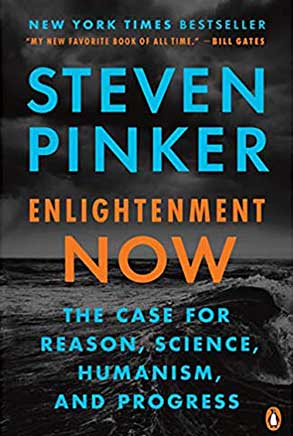
Enlightenment Now: The Case for Reason, Science, Humanism, and Progress
By Steven Pinker
Review by Jeff Eckel, Chairman and CEO
Oh, to be an author and have Bill Gates call your work “My new favorite book of all time.” Pinker writes a vast survey of the human condition and finds it in the best shape it has ever been. From life expectancy, health and decline of diseases worldwide, to peace, democracy and human rights, data is convincingly presented to support the conclusion that people, and society have never had it better.
The first section of the book is a refresher of the Enlightenment, when reason and science triumphed over blind faith in religion, particularly it’s human purveyors. It encouragingly contains a prominent review of the Second Law of Thermodynamics the “foundation of the universe and our place in it” and quotes Eddington who calls it “the supreme law of nature.” My entire four-decade career has been focused on the 2nd Law, since a Geography of Energy course as a junior in college. It underpins one-third of our investment thesis and is the foundation of energy efficiency, our largest business. How promising!
read more....
The second and largest part of the book focuses on the spectacular improvements in 13 dimensions of the human condition and one, chapter 10, in the middle of the section, on the environment. This is the first sign that he might also need to focus on the First Law of Thermodynamics, energy in a system is a constant, as well as the Second. How did so many good things happen to humans? What is the source of this bounty? Physics requires balance in the system. Pinker does not. Rather than sticking to the good start of integrating the 2nd Law into the progress of the human condition, he separates it and then needlessly enters a diatribe on the long history of environmental alarmists from the first “Limits to Growth” to Naomi Klein bashing. He ignores the possibility that the environmental issues, that were perhaps overstated in hindsight, might also have substantial elements of truth. He concludes “But resources just refuse to give out”, forgetting the Second Law, that there is entropy (e.g. excess CO2) in the resources that ‘refuse to give out’. Pinker believes climate change is serious and must be addressed now and has useful solutions (carbon pricing, nuclear power and even ‘moderate’ climate engineering). But somehow it sits awkwardly outside of the other 13 chapters, as if it can be separated.
The final section is a plea to return to reason, science and humanism, set against the modern complications of dogmatism, digital information explosion and unprecedented complexity in everything. He surveys a lifetime of reading suggestions, convincing me that I can learn much from more study of this section. In the end the plea to ‘apply knowledge to enhance human flourishing’ is of course compelling.
In an email correspondence with Pinker last summer, I congratulated him on the book and suggested he could improve the second edition with a more integrated consideration of the Second Law. He referred me to the orphaned Chapter 10. I will send him the link to this review and see if I can’t get him more engaged. I’m no Bill Gates, but that doesn’t mean this compelling book can’t be improved.
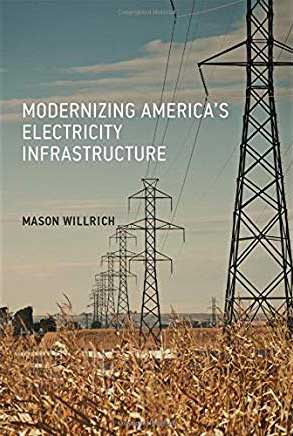
Modernizing America’s Electricity Infrastructure
By Mason Willrich
Review by Bessie Clark, Director – Private Investment Team
Willrich proposes a comprehensive national strategy to modernize the electric grid sustainably, affordably and reliably. He is the first to detail a coherent framework, and in doing so thoughtfully considers the vast complexities of our critical infrastructure across multiple stakeholders, participants and jurisdictions.
In Part I “The Past”, Willrich guides readers through the history of the grid, from the invention of the lightbulb through the evolution of today’s regional power markets. Willrich explains the key industry-shaping events over the 140-year history of electricity, including Three Mile Island, enactment of PURPA, collapse of Enron, and the creation of IPP model.
read more....
Part II, “The Present” offers a snapshot of the U.S. electric power sector in 2015, including resource mix, ownership, and regulatory regime. This sets the stage for Willrich’s recommendations in the final section, Part III, where he lays out a vision for the future of the electricity grid. Willrich’s strategy focuses on four overarching principles – reliability, security, sustainability, financeability – and concludes with 15 detailed recommendations for putting a transformative plan into action.
Of particular interest is his suggestion that intensive financial oversight will be required for modernization of the grid, to avoid excessive leverage and address high technology and market risks. Here I think he misses the mark and believe the analysis would benefit from further discussion of the critical role that private sector financing will continue to play in achieving grid modernization.
For anyone in the energy industry, this is a must-read that offers valuable context for the evolution of the grid, acts as a guide to its regulatory complexities and, most importantly, provides a foundation for understanding the immense opportunity that lies ahead.
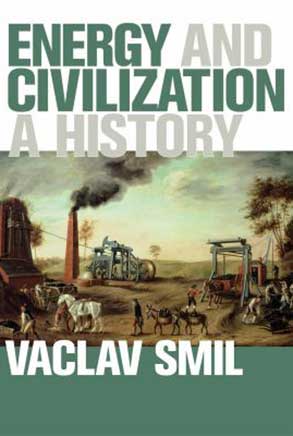
Energy and Civilization: A History
By Vaclav Smil
Review by Tyler Broyles, Manager – Accounting
Over the course of 440 pages, Vaclav Smil takes readers from humanity’s first application of energy – using campfires for cooking – through the many advances on the path to our modern electrified world.
Rather than limiting his discussion to high-level sea changes, Smil explores a host of incremental advances that humans have used to harness energy, including detailed sections covering improvements in plows and harnesses as well as the transition from undershot-style to overshot-style waterwheels.
read more....
As you might expect, this makes for a dense read. Thankfully, Smil provides a variety of graphics to bring the story to life – including charts and drawings of the various industrial mills and machines. As the story unfolds, Smil provides a keen analysis of the industrial era and the 20th century, highlighting both the increase in the availability of energy and our ability to use it efficiently. While several of the examples such as lighting and transportation are quite obvious, Smil also dives into the less familiar but equally impactful ways we’ve put energy to work over the years – such as Haber-Bosch ammonia synthesis, which is employed in fertilizing a large portion of the planet’s crops. By not limiting the discussion to Western Europe and North America in this section, Smil deserves extra credit for his broad geographic and cultural focus.
While the majority of Energy and Civilization is a well-researched matter of fact historical readout, Smil chose to editorialize more in the final chapter when highlighting the carbon crisis and his appropriate fears for the future. However, Smil does not devote many pages to what he believes the answer is to this growing problem. While it’s reasonable to assume this is may be outside the scope of an already voluminous work, one can’t help but be curious of the author’s views on possible solutions given his vast knowledge on the subject at hand.
In closing, Smil emphasizes that change comes gradually and that various eras of energy production generally overlap, pointing out that draft horse usage in American agriculture did not peak until 1917, well after coal began to rise. We know that to meet the goals of the Paris Climate Accord, we will need to transition to new, cleaner energy sources faster than we have been able to historically.
Despite the lack of emphasis on the future, Energy and Civilization is a thorough and intelligent text – a reliable resource for students of energy and history alike.
